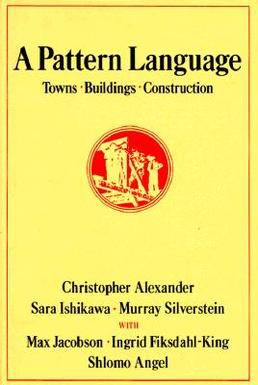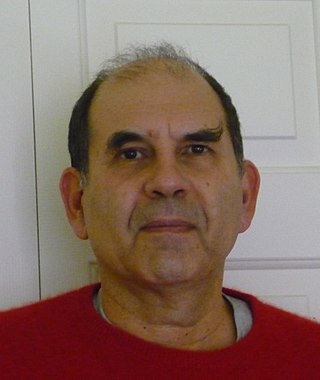
Christopher Wolfgang John Alexander was an Austrian-born British-American architect and design theorist. He was an emeritus professor at the University of California, Berkeley. His theories about the nature of human-centered design have affected fields beyond architecture, including urban design, software, and sociology. Alexander designed and personally built over 100 buildings, both as an architect and a general contractor.

In mathematics, a fractal is a geometric shape containing detailed structure at arbitrarily small scales, usually having a fractal dimension strictly exceeding the topological dimension. Many fractals appear similar at various scales, as illustrated in successive magnifications of the Mandelbrot set. This exhibition of similar patterns at increasingly smaller scales is called self-similarity, also known as expanding symmetry or unfolding symmetry; if this replication is exactly the same at every scale, as in the Menger sponge, the shape is called affine self-similar. Fractal geometry lies within the mathematical branch of measure theory.
A meme is an idea, behavior, or style that spreads by means of imitation from person to person within a culture and often carries symbolic meaning representing a particular phenomenon or theme. A meme acts as a unit for carrying cultural ideas, symbols, or practices, that can be transmitted from one mind to another through writing, speech, gestures, rituals, or other imitable phenomena with a mimicked theme. Supporters of the concept regard memes as cultural analogues to genes in that they self-replicate, mutate, and respond to selective pressures. In popular language, a meme may refer to an Internet meme, typically an image, that is remixed, copied, and circulated in a shared cultural experience online.

A pattern is a regularity in the world, in human-made design, or in abstract ideas. As such, the elements of a pattern repeat in a predictable manner. A geometric pattern is a kind of pattern formed of geometric shapes and typically repeated like a wallpaper design.
A pattern language is an organized and coherent set of patterns, each of which describes a problem and the core of a solution that can be used in many ways within a specific field of expertise. The term was coined by architect Christopher Alexander and popularized by his 1977 book A Pattern Language.

Mathematics and architecture are related, since, as with other arts, architects use mathematics for several reasons. Apart from the mathematics needed when engineering buildings, architects use geometry: to define the spatial form of a building; from the Pythagoreans of the sixth century BC onwards, to create forms considered harmonious, and thus to lay out buildings and their surroundings according to mathematical, aesthetic and sometimes religious principles; to decorate buildings with mathematical objects such as tessellations; and to meet environmental goals, such as to minimise wind speeds around the bases of tall buildings.
Critical regionalism is an approach to architecture that strives to counter the placelessness and lack of identity of the International Style, but also rejects the whimsical individualism and ornamentation of Postmodern architecture. The stylings of critical regionalism seek to provide an architecture rooted in the modern tradition, but tied to geographical and cultural context. Critical regionalism is not simply regionalism in the sense of vernacular architecture. It is a progressive approach to design that seeks to mediate between the global and the local languages of architecture.

A Pattern Language: Towns, Buildings, Construction is a 1977 book on architecture, urban design, and community livability. It was authored by Christopher Alexander, Sara Ishikawa and Murray Silverstein of the Center for Environmental Structure of Berkeley, California, with writing credits also to Max Jacobson, Ingrid Fiksdahl-King and Shlomo Angel. Decades after its publication, it is still one of the best-selling books on architecture.
Construction grammar is a family of theories within the field of cognitive linguistics which posit that constructions, or learned pairings of linguistic patterns with meanings, are the fundamental building blocks of human language. Constructions include words, morphemes, fixed expressions and idioms, and abstract grammatical rules such as the passive voice or the ditransitive. Any linguistic pattern is considered to be a construction as long as some aspect of its form or its meaning cannot be predicted from its component parts, or from other constructions that are recognized to exist. In construction grammar, every utterance is understood to be a combination of multiple different constructions, which together specify its precise meaning and form.
Urban morphology is the study of the formation of human settlements and the process of their formation and transformation. The study seeks to understand the spatial structure and character of a metropolitan area, city, town or village by examining the patterns of its component parts and the ownership or control and occupation. Typically, analysis of physical form focuses on street pattern, lot pattern and building pattern, sometimes referred to collectively as urban grain. Analysis of specific settlements is usually undertaken using cartographic sources and the process of development is deduced from comparison of historic maps.

Deconstructivism is a movement of postmodern architecture which appeared in the 1980s. It gives the impression of the fragmentation of the constructed building, commonly characterised by an absence of obvious harmony, continuity, or symmetry. Its name is a portmanteau of Constructivism and "Deconstruction", a form of semiotic analysis developed by the French philosopher Jacques Derrida. Architects whose work is often described as deconstructivist include Zaha Hadid, Peter Eisenman, Frank Gehry, Rem Koolhaas, Daniel Libeskind, Bernard Tschumi, and Coop Himmelb(l)au.

Nikos Angelos Salingaros is a mathematician and polymath known for his work on urban theory, architectural theory, complexity theory, and design philosophy. He has been a close collaborator of the architect Christopher Alexander, with whom Salingaros shares a harsh critical analysis of conventional modern architecture. Like Alexander, Salingaros has proposed an alternative theoretical approach to architecture and urbanism that is more adaptive to human needs and aspirations, and that combines rigorous scientific analysis with deep intuitive experience.
Architectural design values make up an important part of what influences architects and designers when they make their design decisions. However, architects and designers are not always influenced by the same values and intentions. Value and intentions differ between different architectural movements. It also differs between different schools of architecture and schools of design as well as among individual architects and designers.

Mathematics and art are related in a variety of ways. Mathematics has itself been described as an art motivated by beauty. Mathematics can be discerned in arts such as music, dance, painting, architecture, sculpture, and textiles. This article focuses, however, on mathematics in the visual arts.
Intelligence-based design is the purposeful manipulation of the built-environment to effectively engage humans in an essential manner through complex organized information. Intelligence-Based Theory evidences the conterminous relationship between mind and matter, i.e. the direct neurological evaluations of surface, structure, pattern, texture and form. Intelligence-Based Theory maintains that our sense of well-being is established through neuro-engagement with the physical world at the deepest level common to all people i.e. "Innate Intelligence."

The Timeless Way of Building is a 1979 book by Christopher Alexander that proposes a new theory of architecture that relies on the understanding and configuration of design patterns. Although it came out later, it is essentially the introduction to A Pattern Language and The Oregon Experiment, providing the philosophical background to the Center for Environmental Structure series.

Morphology in architecture is the study of the evolution of form within the built environment. Often used in reference to a particular vernacular language of building, this concept describes changes in the formal syntax of buildings and cities as their relationship to people evolves and changes. Often morphology describes processes, such as in the evolution of a design concept from first conception to production, but can also be understood as the categorical study in the change of buildings and their use from a historical perspective. Similar to genres of music, morphology concertizes 'movements' and arrives at definitions of architectural 'styles' or typologies. Paradoxically morphology can also be understood to be the qualities of a built space which are style-less or irreducible in quality.
Michael West Mehaffy is an urbanist, architectural theorist, urban philosopher, researcher, educator, and executive director of Sustasis Foundation, based in Portland, Oregon, USA.
Complementary architecture is a movement in contemporary architecture promoting architectural practice rooted in comprehensive understanding of context, aiming to contribute to the environment in such a way as to continue and improve or emphasise its preexisting qualities. Indispensable features of complementary architecture include sustainability, altruism, contextualism, endemism and continuity of specific regional design language.
Nir Haim Buras is an Israeli-American architect, urban planner, author, educator, and endorser of the New Classical Architecture movement. He founded the Classic Planning Institute in Washington, D.C. after having published his book, "The Art of Classic Planning: Building Beautiful and Enduring Communities", with support from the Driehaus Foundation.










